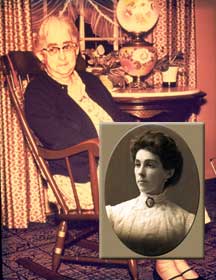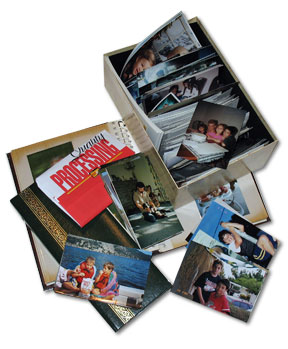
Protect your most valuable
"Fambly" possessions.
"If the house burned down, the thing I would miss the most is the family photo album." This is a common fear of many people. And it does not take a fire or flood to destroy or damage them. Time or a three year old looking for a cool place to color will do just as bad! Your family photos are priceless and irreplaceable unlike the ugly 10 year old sofa in the living room.They are who you are and in many cases where you came from. Generations of history and memories. Today it is very easy to safeguard against a tragedy.
Digital archives are safe, easy
and relatively cheap.
Step one: Collect the photos that mean the most to you and bring them to a local source to have them scanned. Most towns and cities have a Kinko's, Office Max. Staples or similar store that will scan your precious photos for a very reasonable cost and put them on a flash drive, CD or DVD.
Another option if you have a decent digital camera i sto take photos of your photo prints! Be sure to light the prints evenly and avoid strong highlights and reflections.
Step two: Be selective. Although the service is really not expensive, scanning 7 shoe boxes of photos can be. So edit first and then bring them in.
Step three: Choose a resolution (sharpness) that is most practical. Ideally you want to have an image scanned at 300 dpi (dots per sq. inch), but these files will be quite large even in the universal .jpg condensed format. Typically they can be from 3 to 10 or more megabytes. They will not be very good for e-mailing unless you have a program such as Photoshop Elements TM that you can use to edit the photos. Very often 200 or 150 dpi is good enough. If in doubt ask for 300 dpi. You can always have them edited smaller, but you cannot make a low resolution photo better by increasing the resolution!
Step four: Choose a format. We recommend .jpg (jay-peg) because it is universally recognized by almost all photo editing programs and is compatible with both Mac and PC.
Step five: Make copies and keep at least one in a safe place. If the house burns down and takes you photos with it, it will do no good if your CD archives are in the same house! If you have a safe deposit box at the bank, a CD will fit there very easily. If you do not, then keep at least one off site at the office at work, or even Aunt Martha's house. Chances are unless you are very unlucky, both your house and Aunt Martha's will not be swept away in a flood or fire simultaneously!
If you have a CD burner on your computer, you can use the master to make additional copies or selectively load the images to you computer.
The easiest and least expensive way i sto simply put you photos on a USB flash drive (aka thumb drive)
It's as simple as that to keep a record of you entire family history going away in a heartbeat!
More valuable uses for you:
Everything on paper will fade or go bad over time, so having a digital scan of important family images will preserve their original quality. In addition, once a photo is digitized you can:
- Share one-of-a-kind photos such as that old print of great grandma with any member of the family. A good way to avoid arguing over who gets the photo of Uncle Charley.
-Bring them to a photo finish store to be printed or enlarged
-Put the low resolution versions on your computer for wallpaper or a screen saver.
- Have them retouched or restored.
- Add them to e-mails or web sites
- Have composite images created from groups of shots.
